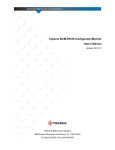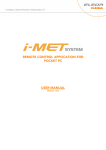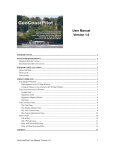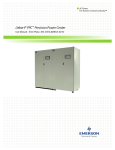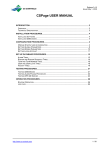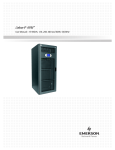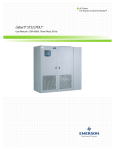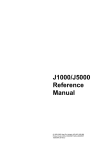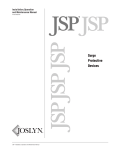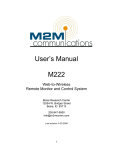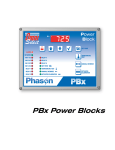Download MFCM-CM_Users_Manual
Transcript
BRANCH/SUBFEED/MAIN FEED CIRCUIT MANAGEMENT Cyberex MFCM Configurator/Monitor User's Manual Version 1.4.0 Updated: 07/16/09 Thomas & Betts Power Solutions 5900 Eastport Boulevard y Richmond, VA 23231-4453 Tel: 800-238-5000 y Fax: 804-236-4047 Cyberex MFCM Configurator/Monitor User's Manual Updated 07/16/09 Version 1.4.0 Page 2 of 14 TABLE OF CONTENTS TABLE OF CONTENTS ................................................................................................................................ 2 1.0 Program Description........................................................................................................................... 2 2.0 PC System Requirements.................................................................................................................. 2 3.0 Installation .......................................................................................................................................... 2 4.0 The Initial Login .................................................................................................................................. 2 5.0 PC Comm. Settings............................................................................................................................ 4 6.0 General Comm. Port Usage on the MFCM ........................................................................................ 4 7.0 The Panel Window ............................................................................................................................. 4 8.0 The Main Feed Windows ................................................................................................................... 5 8.1 Changing Settings on the Main Feed Windows ............................................................................. 6 8.2 Resetting Latched Alarms and Warnings ....................................................................................... 7 8.3 Calibrating the MFCM..................................................................................................................... 7 9.0 The System Settings Window ............................................................................................................ 8 10.0 Upgrading/Downgrading the MFCM Firmware............................................................................... 8 11.0 Terminal Window .......................................................................................................................... 11 12.0 Temporarily Closing the PCs Serial Port ...................................................................................... 11 13.0 Creating Service Port Script Files................................................................................................. 11 13.1 Procedure for Creating a New Script File ................................................................................. 12 13.2 Procedure for Creating a "Verify Script File"............................................................................. 13 14.0 Running Service Port Script Files................................................................................................. 13 1.0 Program Description This program can be used for configuring and monitoring the data on the Cyberex Main Feed Circuit Monitor (MFCM). It can be used in either of the following communications modes: RS-232, RS-485, or TCP. Limited configuration can be done when in the RS-485 or TCP modes. 2.0 3.0 PC System Requirements • IBM Pentium or higher (or compatible) PC with a free serial port, network interface card, and a minimum screen resolution setting of 1024 by 768. • Microsoft Windows 2000 or higher. Installation This program can be installed by double-clicking the 'MFCM-CM_Setup_vX_X_X_X.exe' file provided and following the on-screen instructions. This setup program will put a shortcut on the Desktop and in the Windows StartÆPrograms folder. 4.0 The Initial Login When the program is started, the main window will appear as shown in Figure 4-1 below. Thomas & Betts Power Solutions y 5900 Eastport Boulevard y Richmond, VA 23231-4453 Cyberex MFCM Configurator/Monitor User's Manual Updated 07/16/09 Version 1.4.0 Page 3 of 14 Figure 4-1 – The Main Screen An initial login is required before using the program. Once you are logged in, you have the option of logging out between uses, or remaining logged in for future uses. To log in, click FileÆLogin in the main menu bar. The Login dialog box will open as shown below. There are three login levels as follows. User Name Default Password Permissions 0 Default Default Permission to view meter readings and settings only. 1 Administrator Admin 2 Supervisor Super Level Permission to configure and calibrate the MFCM in addition to those of Level 0 (above). Permission to upgrade/downgrade the MFCM firmware, to change the MFCM passwords, and to use configuration script files, in addition to those of Level 1 (above). When you are finished using the program, you have the option of logging out or remaining logged in for the next use. To log out, click FileÆLogout in the main menu bar. Thomas & Betts Power Solutions y 5900 Eastport Boulevard y Richmond, VA 23231-4453 Cyberex MFCM Configurator/Monitor User's Manual Updated 07/16/09 5.0 Version 1.4.0 Page 4 of 14 PC Comm. Settings Once you are logged in and you are connected to the DB9 (RS-232) connector on an MFCM unit via a null-modem serial cable, the MFCM Configurator/Monitor program should start polling the unit. If not, you may need to change settings on the "PC Comm. Settings" dialog box (FileÆPC Comm Settings on the main menu bar) as shown below. Figure 5-1 – The PC Comm Settings Dialog Box The program defaults to the RS-232 Mode and the COM1 Port as shown above. If needed, select a different Comm port and click the OK button to save the new setting. 6.0 General Comm. Port Usage on the MFCM The MFCM is designed to be configured using the RS-232 Mode (via the DB9 connector). When using this mode, the baud and Slave ID settings can be changed without affecting the communications. The various baud and Slave ID settings on the MFCM affect only the RS-485 Mode (via the terminal block). In RS-232 Mode, the baud is always "9600" and the Slave ID is always "7". The Baud and Slave ID settings on the "PC Comm Settings" dialog box (above) show the settings that will be applied in RS-485 Mode. Note that these settings are disabled (grayed-out) when RS-232 Mode is selected as shown in the figure above. 7.0 The Panel Window When the program is started and the polling begins, the Panel window will appear as shown below. Thomas & Betts Power Solutions y 5900 Eastport Boulevard y Richmond, VA 23231-4453 Cyberex MFCM Configurator/Monitor User's Manual Updated 07/16/09 Version 1.4.0 Page 5 of 14 Figure 7-1 – Panel Window Left-clicking on any of the CB buttons on the Main Control window will cause the associated Main Feed window to open, as shown in a later section below. (Multiple Main Feed windows can be opened at the same time.) Any of the Main Feeds can be disabled or enabled by right-clicking on any of the corresponding CB buttons on the Main Control window and clicking the Disable or Enable popup, as shown below. When a Main Feed is disabled, its CB buttons will appear grey on the Main Control window as shown below. When a Main Feed is enabled, its CB buttons will appear green if no alarms or warnings exist for that circuit, or will appear red or yellow if there are any alarms or warnings, respectively. 8.0 The Main Feed Windows The metering, alarm/warning states, and configuration settings for each Main Feed can be seen in its Main Feed window as shown below. Active alarms and warnings will appear as red or yellow, respectively. Thomas & Betts Power Solutions y 5900 Eastport Boulevard y Richmond, VA 23231-4453 Cyberex MFCM Configurator/Monitor User's Manual Updated 07/16/09 Version 1.4.0 Page 6 of 14 These windows can be opened by either clicking a corresponding CB button on the Main Control window, or by selecting it from ViewÆMain Feed x in the main menu bar. Figure 8-1 – Main Feed Window 8.1 Changing Settings on the Main Feed Windows When logged in on Level 1 or 2, you can change the settings in the Main Feed windows by doubleclicking in the setting you want to change. When this is done, enter the new number into the popup dialog box that appears as shown below. Any setting inside the "Alarms/Warning and Settings" frame can be changed like this. Also, when logged in on Level 1 or 2, you can reset the Min/Max Currents and the KWH readings by clicking the "Reset Meters" button on the Main Feed window. Thomas & Betts Power Solutions y 5900 Eastport Boulevard y Richmond, VA 23231-4453 Cyberex MFCM Configurator/Monitor User's Manual Updated 07/16/09 Version 1.4.0 Page 7 of 14 Figure 8-2 – Changing Settings in the Main Feed Window 8.2 Resetting Latched Alarms and Warnings When logged in on Level 1 or 2, and the "Latching Alarms/Warnings" option is enabled (see the "Latching Alarms/Warnings" checkbox on the System Settings window), you can reset latched alarms and warnings by double-clicking on the red or yellow alarm/warning boxes on the Main Feed window. This will reset all of the alarms and/or warnings that are common with a certain Modbus register. These alarms/warnings are grouped as follows. • OC Alarms (øA, øB, øC, Neut.) • OC Warnings (øA, øB, øC) • UC Alarms (øA, øB, øC) • Over KW Alarms (øA, øB, øC) • All OV/UV Alarms/Warnings • Phase Loss Alarm 8.3 Calibrating the MFCM Note: This function is available only in RS-232 mode. When logged in on Level 1 or 2, you can calibrate the MFCM using the controls on the Calibration frame on the Main Feed windows. There are 7 calibration types that can be selected using the dropdown box in the Main Feed window as shown below. For calibration instructions, refer the proper Field Service procedure. Thomas & Betts Power Solutions y 5900 Eastport Boulevard y Richmond, VA 23231-4453 Cyberex MFCM Configurator/Monitor User's Manual Updated 07/16/09 Version 1.4.0 Page 8 of 14 Figure 8-3 – Calibration Type Selection in the Main Feed Window 9.0 The System Settings Window The system level configuration settings can be seen in the System Settings window as shown below. This window can be opened by selecting ViewÆSystem Settings in the main menu bar. Figure 9-1 – System Settings Window When logged in on Level 1 or 2, you can change the settings in the System Settings window. The first three items are changed by double-click, just like previously mentioned for the settings on the Main Feed windows. The remaining items can be changed by clicking the checkboxes or selecting a different value in the combo (dropdown) boxes. 10.0 Upgrading/Downgrading the MFCM Firmware You must be in RS-232 mode and logged in on Level 2 to use the MFCM Configurator/Monitor application for upgrading or downgrading the MFCM firmware. To see the Upgrade page as shown below, click on the Upgrade tab on the Main Control window. When the program is installed, it is not configured with any "Software Upgrade File" paths, which would appear in the combo box in the Upgrade Software page as shown below. Software upgrade file paths can be added, removed and saved by the program so that they will still be there when the program is closed and reopened later. A new software upgrade file path can be added by dragging from Windows Explorer and dropping into the white "Software Upgrade File" combo box. Then it can be saved for future use by clicking the Save button. You can also add a new software upgrade file path by clicking the Browse button just below the "Software Upgrade File" combo box. A new window will open as shown in Figure 10-2 below. This is a standard "File->Open" dialog box that lets you browse through folders so that you can find and select the upgrade file that you need. Click the Open button after selecting the correct upgrade file as shown below. Once a new software upgrade file path selected, the Save button (below the white combo box) will become enabled. You can then save the new software upgrade file path in the list by clicking the Save button. To see the software upgrade file paths in the list, click on the down-arrow button on the right-hand side of the combo box as shown below in Figure 10-3. Then you can select the file that you want to use for the upgrade. Thomas & Betts Power Solutions y 5900 Eastport Boulevard y Richmond, VA 23231-4453 Cyberex MFCM Configurator/Monitor User's Manual Updated 07/16/09 Version 1.4.0 Page 9 of 14 Note: To remove a path from the list, simply select the path and click the Remove button in that frame. When a software upgrade file is selected (like shown in Figure 10-3), you can click the "Open Folder" button (in the same frame) to open its folder with the file selected in Windows Explorer. This is handy for checking file dates, etc. Figure 10-1 – Upgrade Page Figure 10-2 – Browsing Software Upgrade Files Thomas & Betts Power Solutions y 5900 Eastport Boulevard y Richmond, VA 23231-4453 Cyberex MFCM Configurator/Monitor User's Manual Updated 07/16/09 Version 1.4.0 Page 10 of 14 Figure 10-3 – Selecting Saved Software Upgrade Files Once the software upgrade file is selected, click the Upgrade button to start the upgrade. The File Transfer Progress bar should start growing and the "Upgrade in process" message should appear as shown below. The Cancel button can be clicked to stop the upgrade, if needed. Figure 10-4 – Software Upgrade in Process The upgrade file transfer takes about 1 ½ minutes. After the file transfer has completed, you should see the following message box pop up. After clicking the OK button, you should see the following message box pop up. After acknowledging these two messages, the MFCM should start running with the new software upgrade loaded. Thomas & Betts Power Solutions y 5900 Eastport Boulevard y Richmond, VA 23231-4453 Cyberex MFCM Configurator/Monitor User's Manual Updated 07/16/09 Version 1.4.0 Page 11 of 14 11.0 Terminal Window When logged in on Level 1 or 2, you can open the Terminal window as shown below by selecting ConnectionÆTerminal on the main menu bar. Figure 11-1 – Terminal Window When the Terminal window is open, enter service port commands into the smaller lower textbox. 12.0 Temporarily Closing the PCs Serial Port The PCs serial port can be temporarily closed and reopened without exiting the MFCM Configurator/Monitor application by selecting ConnectionÆDisconnect and ConnectionÆConnect on the main menu bar. This is convenient to use when you want to temporarily communicate with the MFCM with another application. 13.0 Creating Service Port Script Files This application can be used to create service port script files to use for configuring MFCM units and for verifying the settings after configuring. This feature works only in RS-232 mode and when logged in to Security Level 2. To open the Create Script File window, select ScriptsÆCreate Script in the main menu bar. The window will open as shown below. Thomas & Betts Power Solutions y 5900 Eastport Boulevard y Richmond, VA 23231-4453 Cyberex MFCM Configurator/Monitor User's Manual Updated 07/16/09 Version 1.4.0 Page 12 of 14 Figure 13-1 – The Create Script File Window 13.1 Procedure for Creating a New Script File The following procedure can be used for creating a new script file. 13.1.1 Clear the Script File Text Box 13.1.1.1 Clear the Script File Text Box by clicking the Clear Text button. 13.1.2 Add System Settings to the Script File Text as Follows: 13.1.2.1 Starting at the upper left-hand corner of the window, select a System Setting you want to add to the script file by clicking the item in the Item frame. 13.1.2.2 Enter the new value you want to for this item in the Value textbox. 13.1.2.3 Click the Add to Script button to add this command to the script file. The new command line should appear in the large Script File Text box on the right-hand side of the window. Note: The text in the Script File Text box can be manual edited or deleted, like using Notepad. 13.1.2.4 You can repeat this process to add other "System Settings" items, if required. 13.1.3 Add Panel Settings to the Script File Text as Follows: 13.1.3.1 Select a Panel Setting you want to add to the script file by clicking the item in the Panel Settings – Item frame. 13.1.3.2 Enter the new value you want to for this item in the Value textbox. 13.1.3.3 Click the Add to Script button to add this item to the script file. The new command line should appear in the Script File Text box on the right-hand side of the window. Thomas & Betts Power Solutions y 5900 Eastport Boulevard y Richmond, VA 23231-4453 Cyberex MFCM Configurator/Monitor User's Manual Updated 07/16/09 Version 1.4.0 Page 13 of 14 13.1.3.4 You can repeat this process to add other "System Settings" items, if required. 13.1.4 Add Main Feed Settings to the Script File Text as Follows: 13.1.4.1 Select a Main Feed Setting you want to add to the script file by clicking the item in the Main Feed Settings – Item frame. 13.1.4.2 In the Selection frame, select the Main Feed/s you want to add by checking the appropriate checkboxes. The "Select All" button can be used to select or unselect all items in all columns. 13.1.4.3 Enter the new value you want to for this item in the Value textbox. (This value will be used for all Main Feeds selected.) 13.1.4.4 Click the Add to Script button to add this item to the script file. The new command line/s should appear in the Script File Text box on the right-hand side of the window. 13.1.4.5 You can repeat this process to add other "Main Feed Settings" items, if required. 13.1.5 Current Offset Calibration: This application provides the option of putting Current Offset Calibration for each panel into script file. Perform the following steps to add Current Offset Calibration to the script file. 13.1.5.1 To open the Calibration window, click the Calibration button at the lower right-hand side of the Main Feed Settings frame. 13.1.5.2 Click the "Add to Script" button. (See below.) 13.1.6 Save the Script File as Follows: 13.1.6.1 You can edit or delete text in the Script File Text box if necessary. When ready, save the finished script file by clicking the "Save Script File" button. A "Save As" dialog box will appear, prompting you for a new file name for the new script file. The default folder for saving script files is the "\Scripts" subfolder in the application's folder. 13.2 Procedure for Creating a "Verify Script File" After a new script file has been created, it may be a good idea to create another script file to use for verifying that the new settings have been actually been saved in the MFCM after being configured. This "Verify Script File" or "Read File" can be easily created from an existing setup script file as follows. With the script file text in the Script File Text box (e.g., after saving the script file in the procedure above), click the "Make Read File" button. (This changes the text in the Script File Text box into commands for reading data instead of writing data to the MFCM.) Then save the text to a new file by clicking the "Save Script File" button. In the "Save As" dialog box, which will appear, enter a new file name that distinguishes this as a "Verify Script File" or "Read File". 14.0 Running Service Port Script Files This application can be used to run service port script files for configuring MFCM units and for verifying the settings after configuring. This feature works only in RS-232 mode and when logged in to Security Level 2. To open the Script File Transfer window, select ScriptsÆRun Script in the main menu bar. The window will open and the Terminal window should open a few seconds later as shown below. Thomas & Betts Power Solutions y 5900 Eastport Boulevard y Richmond, VA 23231-4453 Cyberex MFCM Configurator/Monitor User's Manual Updated 07/16/09 Version 1.4.0 Page 14 of 14 The program will load the last script file used. To load another script file, click the Browse button and select an existing script file in the "Open" dialog box, which will appear. (The "Script File Transfer" window can also be opened from the "Create Script File" window by click the "Run Script" button in that window. When opened this way, the current script file in the "Create Script File" window will be loaded into the "Script File Transfer" window.) When you have the correct script file loaded, click the Run button in the "Script File Transfer" window. You should see the highlighter bar shift down in the "Script" list box and the commands being echoed in the Terminal Interface textbox in the Terminal window. Thomas & Betts Power Solutions y 5900 Eastport Boulevard y Richmond, VA 23231-4453














